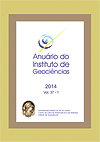Main Brazilian Paleontological Collections
DOI:
https://doi.org/10.11137/2014_2_48_59Keywords:
Museum collections, Paleontology, Brazil.Abstract
Main Brazilian paleontological collections. This paper presents a summary of major paleontological collections in Brazil, without regard to institutions that are closed to reform or with predominantly didactic or academic collections. From thirty institutions listed, twelve of them are located in the southeast (Rio de Janeiro, Belo Horizonte, Peirópolis, Ouro Preto, São Paulo, Rio Claro, Taubaté and Monte Alto), ten in the northeast (Ceará, Rio Grande do Norte, Pernambuco, Sergipe and Bahia), five in the southern (Mafra, Porto Alegre, São Leopoldo and Santa Maria), two in the northern region (Acre and Pará), and one in central Brazilian region. The largest fossil collections in Brazil are in the Museu de Ciências da Terra of the DNPM and the Museu Nacional, both in Rio de Janeiro, which gather around 260,000 specimens, even in Aracaju, Sergipe, is the third largest Brazilian paleontological collection, with approximately 38,000 fossils belonging to the Fundação Paleontológica Phoenix. The most thematic collections are related to Cretaceous fossils, which is concordant with the abundance of Brazilian fossils of this age: in the northeast region, the collections are notables by the large number of invertebrates and fishes, and in Minas Gerais and São Paulo, by their reptiles. Other thematic collections are in Rio Grande do Sul (Triassic reptiles), São Paulo (Mesozoic trace fossils), Santa Catarina (Paleozoic invertebrates), Ceará and Pernambuco (Siluro-Devonian trace fossils), and Ceará, Bahia, Minas Gerais and Acre (Cenozoic megafauna). The oldest museums of Brazil with paleontological collections are all centenarians: the Museu Nacional, established in 1818 in Rio de Janeiro, Museu Paraense Emílio Goeldi, opened in 1866 in Belém, and the Museu de Ciência e Técnica in Ouro Preto, created in 1884.Downloads
Download data is not yet available.
Downloads
Published
2017-02-15
How to Cite
Pássaro, E. M., Hessel, M. H. and Nogueira Neto, J. de A. (2017) “Main Brazilian Paleontological Collections”, Anuário do Instituto de Geociências. Rio de Janeiro, BR, 37(2), pp. 48–59. doi: 10.11137/2014_2_48_59.
Issue
Section
Article
License
This journal is licensed under a Creative Commons — Attribution 4.0 International — CC BY 4.0, which permits use, distribution and reproduction in any medium, provided the original work is properly cited.















